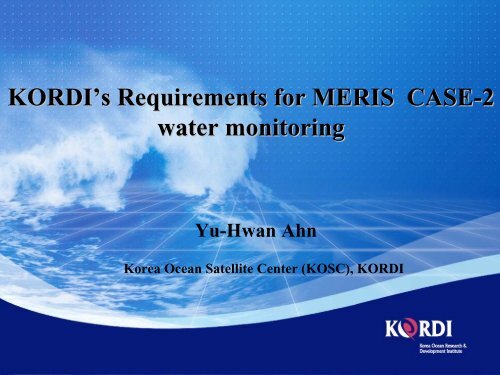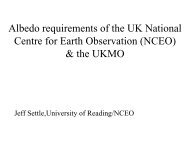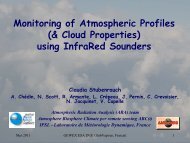KORDI's requirements for MERIS CASE-2 water monitoring - Yu ...
KORDI's requirements for MERIS CASE-2 water monitoring - Yu ...
KORDI's requirements for MERIS CASE-2 water monitoring - Yu ...
- No tags were found...
You also want an ePaper? Increase the reach of your titles
YUMPU automatically turns print PDFs into web optimized ePapers that Google loves.
KORDI’s s Requirements <strong>for</strong> <strong>MERIS</strong> <strong>CASE</strong>-2<br />
<strong>water</strong> <strong>monitoring</strong><br />
<strong>Yu</strong>-Hwan Ahn<br />
Korea Ocean Satellite Center (KOSC), KORDI
General Ocean Environment of Korean Sea<strong>water</strong>s<br />
Yellow Sea<br />
Yellow Sea<br />
East Sea<br />
East Sea<br />
Water depths<br />
- East sea(Japan Sea) : ~3km<br />
- Yellow Sea : ~ 80m<br />
- East China Sea : ~ 200m<br />
Turbid <strong>water</strong><br />
East China East Sea China Sea
General Ocean Environment of Korean Sea<strong>water</strong>s<br />
Yellow Sea<br />
East Sea<br />
Yellow color ;<br />
- Shallow &<br />
- Turbid <strong>water</strong>s<br />
Turbid <strong>water</strong><br />
East China Sea
General Ocean Environment of Korean Sea<strong>water</strong>s<br />
Yellow Dust problems<br />
in O.C <strong>monitoring</strong><br />
1. Optical properties of<br />
<strong>water</strong>s are influenced<br />
by the Yellow Dust<br />
2. It’s hard to remove<br />
the atmospheric signal<br />
from total signal<br />
in addition ;<br />
Yellow dust events are<br />
considered as a very<br />
serious natural hazard<br />
in Korea <strong>for</strong> people’s<br />
health
General Ocean Environment of Korean Sea<strong>water</strong>s<br />
Phytoplankton Spring<br />
Bloom at dumping site<br />
27 Mar. 2002<br />
SeaWiFS CHL<br />
Out of existence of the<br />
Phytoplankton Bloom<br />
10 May. 2001<br />
SeaWiFS CHL
General Ocean Environment of Korean Sea<strong>water</strong>s<br />
• Turbid <strong>water</strong> from ECS<br />
- low salinity<br />
- impact on coastal fish farming<br />
A<br />
B<br />
• Source of Suspended<br />
sediment in the East China Sea<br />
A : Wind driven Re-suspended<br />
sediment from bottom ←<br />
Yangtze river<br />
B : Tidal current Re-suspension
General Ocean Environment of Korean Sea<strong>water</strong>s<br />
SeaWiFS Chl-a image<br />
(Sep.16.2003)<br />
KOREA<br />
Pohang<br />
Jin-hae<br />
bay<br />
• Redtide in the Yellow Sea<br />
• Extension of Redtide<br />
to the East-Sea
General Ocean Environment of Korean Sea<strong>water</strong>s<br />
SeaWiFS (12 Jul. 2001)<br />
Red tide Index<br />
SeaWiFS (22 Aug.<br />
2001)<br />
Red tide Index<br />
• Phytoplankton bloom <strong>monitoring</strong> by Redtide Index(RI) in Yellow Sea
General Ocean Environment of Korean Sea<strong>water</strong>s<br />
Green Algae Bloom<br />
• Green Algae Bloom in Yellow/East China Sea(Korea/China)<br />
• Bloom might have been originated from the Sansha Dam(Three Gorges Dam)<br />
• Total removal quantity in Jeju : 196 ton<br />
(Beach : 43 ton, coast : 153 ton)<br />
(32° 35′ 225″N, 126° 35′ 340″E)
General Ocean Environment of Korean Sea<strong>water</strong>s<br />
Green Algae in China<br />
Total removal quantity in Qingdao : about 1 million ton<br />
Sea<br />
During 2008 Beijing Olympic Game, sailing<br />
stadium of Qingdao was attacked by green<br />
algae.
General Ocean Environment of Korean Sea<strong>water</strong>s<br />
• Green Algae Monitoring by MODIS
Ocean Optical Properties of Korean Sea<strong>water</strong>s<br />
• Yellow Sea, ECS & Coastal Area : <strong>CASE</strong>-II <strong>water</strong><br />
• South Sea & ECS : Mixed area of <strong>CASE</strong>-I and <strong>CASE</strong>-II <strong>water</strong><br />
• East Sea(Japan Sea) : <strong>CASE</strong>-I <strong>water</strong><br />
1 :1 line
Ocean Optical Properties of Korean Sea<strong>water</strong>s<br />
• CHL : 0.1 – 100 mg/m 3 (redtide area)<br />
• SS : 0.2 – 100 g/m 3 (in China coastal area, 1000 g/m 3 )
Ocean Optical Properties of Korean Sea<strong>water</strong>s<br />
• IOPs & AOPs spectrum in the Yellow Sea and coastal area
Ocean Optical Properties of Korean Sea<strong>water</strong>s<br />
• IOPs & AOPs spectrum shapes in the Redtide area
KORDI’s proposal <strong>for</strong><br />
CoastColour Project<br />
(<strong>CASE</strong>-II <strong>water</strong> techniques)
Required parameters from CC <strong>MERIS</strong> Data<br />
IOP : Light absorption & backscattering coefficients<br />
AOP<br />
-nL w<br />
: Normalized <strong>water</strong> leaving radiance<br />
-R rs<br />
: Remote sensing reflectance<br />
- K coefficients in blue & green bands<br />
Water’s main parameters<br />
- CHL : Chlorophyll concentration (mg/m 3 )<br />
* Band ratio & Fluorescence technique<br />
- SS : Suspended solid particle matter concentration (g/m 3 )<br />
- CDOM : Absorption coefficient of dissolved organic matter at 400 nm (m -1 )<br />
Water’s sub-parameters<br />
- Algal bloom index (Redtide index; 0 – 1 or 1 - 10) & green floating algae <strong>monitoring</strong><br />
- Water quality(pollution) index (1 – 5)<br />
- Water current vector (cm/sec)<br />
- Under<strong>water</strong> visibility (m)<br />
Etc<br />
- Atmospheric optical thickness - Yellow dust concentration in Atmosphere
Error <strong>requirements</strong> <strong>for</strong> CC <strong>MERIS</strong> Data (I)<br />
Total radiance in orbit (TL) : ±5%<br />
Atmospheric correction in turbid <strong>water</strong>s : ±5%<br />
Water leaving radiance (Lw) : ±5%<br />
-----------------------------------------------------------------<br />
Total error : within ±5%
Algorithms <strong>for</strong> CC <strong>MERIS</strong> Data (I)<br />
- Empirical & semi-analytical methods<br />
- Neural Network etc<br />
* Pure analytical method (future hyper-spectral sat.)<br />
- least requirement : 20 bands,<br />
- optimal bands number : ~60bands
Error Requirements <strong>for</strong> CC <strong>MERIS</strong> Data (II)<br />
Parameters<br />
Units<br />
Clear <strong>water</strong><br />
(Error in Av.)<br />
Turbid <strong>water</strong><br />
(Error in Av.)<br />
nL w mW/cm 2 /μm/sr ±4 % ± 5 %<br />
R rs sr -1 ±4 % ± 5 %<br />
CHL mg/m 3 ±10 % ± 20 %<br />
SS g/m 3 ± 10% ± 10 %<br />
CDOM m -1 ±15% ± 30 %<br />
nL w<br />
: Normalized Water leaving radiance<br />
R rs<br />
: Remote sensing reflectance<br />
CHL : Chlorophyll concentration<br />
SS : Suspended solid particle matter concentration<br />
CDOM : Absorption coefficient of dissolved organic matter at 400 nm
Error Requirements <strong>for</strong> <strong>MERIS</strong> Data (III)<br />
Parameters<br />
RI<br />
(Algal bloom<br />
Index)<br />
Water Pollution<br />
Index<br />
Units<br />
Clear <strong>water</strong><br />
(Error in Av.)<br />
Turbid <strong>water</strong><br />
(Error in Av.)<br />
Range 0.0 – 1.0 % %<br />
Range 1 - 5 % %<br />
Water current m/sec ±20 % ± 20 %<br />
Under<strong>water</strong><br />
Visibility<br />
m ± 10% ± 10 %<br />
CHL-FL mg/m 3 ±10 % ±10 %
KORDI’s s Proposals <strong>for</strong> CC project (I)<br />
‣ An offer of in-situ Ocean Optical and Environmental Data in the<br />
Korean Sea<strong>water</strong>s (Date : 2000 – 2008) <strong>for</strong> the development of the<br />
CoastColour algorithms / Collaboration with CC project.<br />
• L w (λ), E d (λ), R rs (λ) data obtained from field spectroradiometer<br />
• a ph (λ), a ss (λ), a dom (λ) data<br />
• CHL and SS data obtained with optical parameters
KORDI’s Collaboration Proposals (II)<br />
‣ Offering of Near Real-Time in-situ Ocean Optical Data in the<br />
Korean Sea<strong>water</strong>s (suggestion as one of CC test sites)<br />
• FL(0 - ), L w (λ) and E d (λ) data obtained from I-eo-do & new Gageo-cho<br />
(2010 ~) Ocean observing Station<br />
360 o<br />
L wT<br />
L sky<br />
E d<br />
(0 + )
KORDI’s s demand<br />
‣ Service about an offer of <strong>MERIS</strong> data (past data)<br />
• Date : Jan. 2002 – Dec. 2008<br />
• Area : around the Korean Peninsula<br />
• Sat. Data : <strong>MERIS</strong> Level-1 & Level-2
KORDI’s s Proposals (III)<br />
‣ <strong>MERIS</strong> Sat. data Exchange with GOCI<br />
(After launching of GOCI, and if data quality is good)<br />
• GOCI’s Launching Schedule : Nov. 2009<br />
• Data : Level-1B<br />
‣ Proposal <strong>for</strong> GOCI vicarious calibration &<br />
Validation with <strong>MERIS</strong> in Korean <strong>water</strong>s
Thank you


